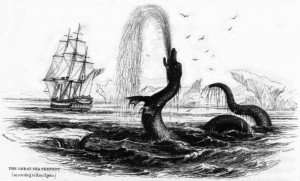July 6th’s Sea Serpent: A Penis?
Posted by: Loren Coleman on July 6th, 2010

Hans Poulsen Egede (January 31, 1686 – November 5, 1758) was a Dano-Norwegian Lutheran missionary who launched mission efforts to Greenland, which led him to be styled the Apostle of Greenland. He established a successful mission among the Inuit and is credited with revitalizing Dano-Norwegian interest in the island after contact had been broken for hundreds of years. He founded Greenland’s capital Godthåb, now known as Nuuk.
Norwegian missionary Hans Egede gave one of the oldest descriptions of a Sea Serpent.

Egede wrote that on July 6, 1734, his ship sailed past the coast of Greenland when suddenly those on board “saw a most terrible creature, resembling nothing they saw before. The monster lifted its head so high that it seemed to be higher than the crow’s nest on the mainmast. The head was small and the body short and wrinkled. The unknown creature was using giant fins which propelled it through the water. Later the sailors saw its tail as well. The monster was longer than our whole ship.”

His description of a snake-like creature with an elongated sharp snout and covered with wrinkled hard skin hardly appears to be a giant squid (Architeuthis), with one of the tentacles mistaken for a tail, which some have used to explain the sighting.

Charles Paxton’s hypothesis is that the famous Egede sighting of 1734 might actually have been of a whale penis, which has been supported with some remarkable photos. Others have mentioned it merely as a misidentified whale.



Hans Egede returned to Copenhagen in 1736 to become principal of a seminary that trained missionaries for Greenland. In 1741, he was named bishop of Greenland. He established a catechism for use in Greenland in 1747. Egede died November 5, 1758 at the age of 72 at Falster, Denmark.
About Loren Coleman
Loren Coleman is one of the world’s leading cryptozoologists, some say “the” leading living cryptozoologist. Certainly, he is acknowledged as the current living American researcher and writer who has most popularized cryptozoology in the late 20th and early 21st centuries.
Starting his fieldwork and investigations in 1960, after traveling and trekking extensively in pursuit of cryptozoological mysteries, Coleman began writing to share his experiences in 1969. An honorary member of Ivan T. Sanderson’s Society for the Investigation of the Unexplained in the 1970s, Coleman has been bestowed with similar honorary memberships of the North Idaho College Cryptozoology Club in 1983, and in subsequent years, that of the British Columbia Scientific Cryptozoology Club, CryptoSafari International, and other international organizations. He was also a Life Member and Benefactor of the International Society of Cryptozoology (now-defunct).
Loren Coleman’s daily blog, as a member of the Cryptomundo Team, served as an ongoing avenue of communication for the ever-growing body of cryptozoo news from 2005 through 2013. He returned as an infrequent contributor beginning Halloween week of 2015.
Coleman is the founder in 2003, and current director of the International Cryptozoology Museum in Portland, Maine.










Interesting photos, but taller than the crow’s nest? I think not.
That would have to be the Ron Jeremy of Whales if it was as tall as the Crows Nest, or maybe it was a really small ship. Either way I think the dork hypothesis may come up a little short regardless of the size of the whale’s appendage.
On a separate note, I have been reading this page a while, and it had never occurred to me that one day we would discuss the sexual anatomy of a whale as a possible hypothesis for a sea monster.
That being said, the pictures you have supplied could obviously be thought to be a sea monster if someone who was unfamiliar with whales was observing this phenomenon.
It was a whale penis in swamp gas, reflecting off the light of Venus.
On a serious note, for many years I lived on an island with great proximity to — and sightings of — various whale species. I have never seen a (living) whale penis until this very moment. I guess I have Loren to thank for this morning’s eye-opener!
If you ignore the obvious exaggeration of size and take into account the location and description i think it was a Stellars Sea Cow.
Paul78
There is no evidence that Steller’s sea cows ever lived anywhere outside the northern Pacific ocean. Were there any proof they had ever existed in the far Northern Atlantic, I suspect they would have been cited as suspects in numerous of other historical marine monster sightings.
Reminds me somewhat of when in “Searching For Hidden Animals,” Roy Mackal selects the northern sea elephant as the most likely candidate for the Arkansas’White River Monster, writing (p.206), “found mainly along the Mecican and Southern California coast. It is quite conceivable that occasionally a wandering individual finds itself in the mouth of the Mississippi…”
Sorry, Roy, but only if it was able to make its way through the Panama Canal.
There are plenty of documented cases of vagrant animals in zoology, but putting sea cows in the Atlantic or sea elephants in the Mississippi river system are real stretches, imho.
Oops sorry, i got the wrong ocean!
I believe I’d be doing the back stroke too. Don’t you just hate a show off?